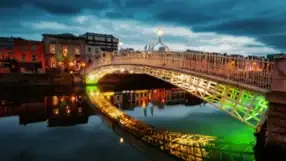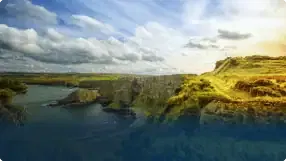Top 10 Things To Do In Dublin
With a history spanning more than a millennium, it should be no surprise that Dublin offers a wealth of attractions. Whether you are looking for a day out, or more Dublin tourist information about what should be on your list of things to do, look no further! All of the attractions covered below are either accessible by foot from Dublin City Centre or easily accessible via public transport.
1: Guinness Storehouse, Dublin

The Guinness Storehouse is the home of Guinness and for many years now the most visited tourist attraction in Ireland. The museum is housed in a seven storey building that served as a fermentation plant from its constructed in 1902 until 1988. The Guinness Storehouse is located in the heart of the St James’s Gate Brewery, and will teach you everything you need to know about Guinness, from the ingredients, the brewing process, the famous marketing campaigns and information about Arthur Guinness himself.
Visitors to the museum can browse all seven floors of the museum, including the Gravity Bar with panoramic views of Dublin. To avoid queues, ensure you book your ticket online.
2: Dublin Zoo
 Dublin Zoo should be on every visitors list for a number of reasons. Such is the popularity of the Zoo that it has received more than one million visitors. First of all, from a historical perspective, Dublin Zoo was opened in 1831 with the purpose of educating and entertaining people. Today the mission of Dublin Zoo has changed to that of conservation, study and education.
The zoo itself is situated on almost 70 acres of parkland with 8 different habitats replicated. For example, the Africa Savannah replicates grassy savannahs and open plains and is home to giraffe, zebras, rhinos and much more.
Dublin Zoo should be on every visitors list for a number of reasons. Such is the popularity of the Zoo that it has received more than one million visitors. First of all, from a historical perspective, Dublin Zoo was opened in 1831 with the purpose of educating and entertaining people. Today the mission of Dublin Zoo has changed to that of conservation, study and education.
The zoo itself is situated on almost 70 acres of parkland with 8 different habitats replicated. For example, the Africa Savannah replicates grassy savannahs and open plains and is home to giraffe, zebras, rhinos and much more.
Dublin Zoo, is located inside Phoenix Park, the largest city park in Europe. Easy accessible via bus, car or tram, Dublin Zoo is a great family day out. To avoid queues on busy weekends, either arrive early or book your tickets online.
3: National Aquatic Centre

The National Aquatic Centre contains a 50meter pool of international competition standard for swimming, diving and water polo. However, the big draw for tourists is the AquaZone water park!
AquaZone is one of the most technically advanced water parks in Europe, offering family fun with attractions such as the Lazy River that will float you around a 120 meter course taking ten minutes. For those looking for more adventure the flow rider simulates surfing while the. In total there are six different areas to explore, guaranteeing fantastic family fun.
4: The Old Library & The Book of Kells

The Book of Kells is found inside the Old Library in Trinity College. Situated in the heart of Dublin City Centre, this attraction is very accessible. Visitors can see the 9th Century Book of Kells, an illustrated gospel manuscript that represents the pinnacle of early Middle Age artistic achievements. Until the 17th Century the book was stored in Kells before being moved to Trinity College for security reasons. During its history, the book has been stolen and at one stage was buried in the ground to keep it secure. The Old Library is interesting in itself and is rumoured to have inspired the libraries in Harry Potter and Star Wars!
5: National Gallery of Ireland

The National Gallery of Ireland is located in the heart of Dublin City Centre, and is home to more than 15,000 forms of art including paintings, sculpture and works of paper dating from the 13th Century to the 20th Century. The gallery is home to the national collection of European and Irish fine art and offers an impressive collection of masterpieces from major European artists and the World’s largest collection of fine Irish art.
When visiting the National Gallery of Ireland, one painting in particular is synonymous. The Taking of Christ by Caravaggio was lost for 200 years before being discovered again in 1990 in the residence of the Society of Jesus in Dublin where it had been hanging since 1930. It had been considered a copy of the lost original since 1802, and was sold as such several times until it was bequeath to the Society of Jesus in the 1930s. Entrance to the National Gallery of Ireland is free of charge.
6. National Botantical Gardens

Situated in the suburb of Glasnevin, less than 5km from Trinity College Dublin sits the National Botanical Gardens. The aim of the gardens is to explore, understand, conserve and share the importance of plants. Today the gardens are home to 20,000 living plant specimens and millions of dried plants.
Visiting the gardens is also worthwhile from an architectural point of view. There are a number of glasshouses of significant architectural importance. The Palm House and the Curvilinear Range in particular are spectacular buildings, dating from the mid-19th Century. Entrance to the gardens is free of charge and there are regular educational exhibits and classes organised.
7. St Patrick’s Cathedral

Built in honour of Saint Patrick, Saint Patrick’s Cathedral is built next to the suspected place of baptism of Saint Patrick himself. The Cathedral that people visit today was constructed in 1220 and serves as a place of worship for Church of Ireland and as an important tourist attraction. In addition – it is the largest church in Ireland which is one reason alone to visit.
Among the reasons to visit the Cathedral is the close connection it has to Saint Patrick, with the now lost well where he was baptised is celebrated in a park next to the Cathedral. In addition, Jonathan Swift, author of Gulliver’s Travels amongst other books is buried here. Inside, the Cathedral is simply stunning. With more than 500,000 visitors annually, this is an attraction that should not be missed.
8. Kilmainham Gaol

The only reason Kilmainham Gaol is not amongst the most popular tourist attractions in Ireland is because visitor numbers are limited. To visit Kilmainham Goal, you must partake in the guided tour. You can’t pre-book your ticket, so plan your visit here early to avoid the rush. Once you get inside, you may recognise the jail as it has featured in several high profile movies.
The jail itself is now the largest unoccupied jail in Europe, but the main reason to visit the jail is because of its close relationship to the 1916 Easter Rising and the eventual formation of the Republic of Ireland free from British Rule. Among the exhibits are the history and restoration of the jail. However, the real highlight is the information about the imprisoning and execution of some of Ireland’s most famous political and military leaders.
9. Dublin Castle

Situated in the middle of Dublin City Centre, Dublin Castle was the seat of British rule in Ireland until 1922. The majority of the castle dates from the 18th Century, however if you partake in the tour of the castle you will visit part of the existing structure underground, complete with moat!
Today the Castle fulfils a number of important official roles, however visitors to the castle will firstly enjoy exploring the central courtyard and secondly be taking the tour of the castle. The tour is fantastic, providing a lot of historical information on the history of Ireland, the history of the castle, and if you have visited Kilmainham Gaol provides insight into the time of the Easter Rising and the function the building served during this time. In addition, when you take the tour of the castle, you will visit a recently discovered section of the out wall of Dublin City & moat.
10. National Museum of Ireland - Archaeology

The National Museum of Ireland (Archaeology) is located on Kildare Street. The museum first opened its doors in 1890. Over the preceding 120 plus years, the building hasn’t changed. Given the museum covers the history of Ireland with exhibits ranging from 7,000 BC to the 20th Century.
Famous exhibits such as the Ardagh Chalice and the Tara Brooch are on display, while specific displays relate to Ireland’s Gold, Prehistoric, Viking and Medieval Ireland while separate exhibits deal with Vikings, Egypt and life and death in the Roman World. Entrance to this museum is free of charge. Given the level of history covered in the museum, the fact that entrance is free and its central location means it shouldn’t be overlooked.
While public transport is easy to get around here, a car rental Dublin offers a convenient option to get to places directly quickly and for day trips outside the city.
Search car rentalsRelated Articles

Top 10 family outings in Ireland
If you're organising a family trip to explore Ireland, have a look at the recommendations here before making travel plans.
Learn More
About the Wild Atlantic Way
Discover our top tips for Ireland's 2,500 kilometres of breathtaking coastline with white sands and sparkling waves along the Wild Atlantic Way path.
Learn More
Top 10 things to do in Dublin
Whether you are looking for a day out, or more Dublin tourist information about what should be on your list of things to do, look no further!
Learn More
About car hire excess
Before you hit the road, it's crucial to understand car hire excess and how it works, especially when you're travelling in a foreign country.
Learn More